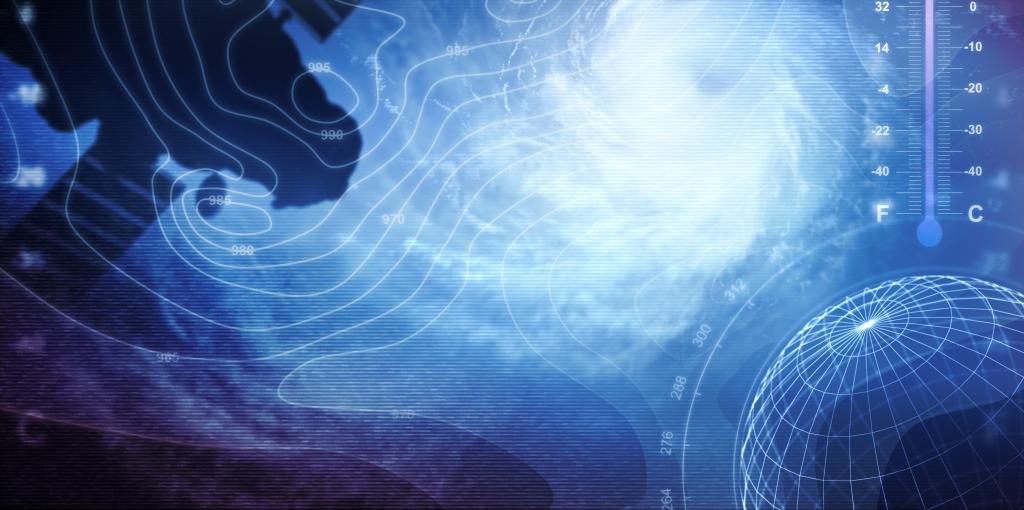2022-2023 Seminars
Admission CTAs
Main navigation
Section Navigation: AOES Seminars
Graduate Symposium
2026 Earth System Observations and Modeling Graduate Symposium, April 10th. Accepting Abstracts.

Spring 2023 AOES Seminars
26 Jan (GEOL) Nohl, Carbonate Chemistry

Theresa Nohl, University of Münster: Carbonate Chemistry
Live in 1309 Exploratory Hall
Virtual simulcast in Zoom: https://gmu.zoom.us/j/95726202745
Thursdays 4:30-5:45 pm
1 Feb (CLIM) Smith, [POSTPONED]
Lenny Smith, Virginia Tech
Wed, 1 Feb, 1:30-2:30 - POSTPONED, New Date TBA
JC Room G and via Zoom (contact bklinger@gmu.edu for link)
On the Evaluation and Tuning of Probability Forecasts: Why RMSE is Evil and Anomalies are Silly
2 Feb (GEOL) Trabucho Alexandre, Mud Sedimentology
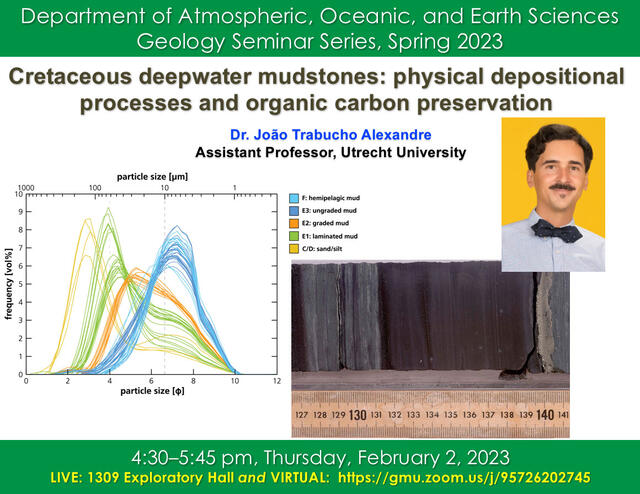
João Trabucho Alexandre, University of Utrecht: Mud Sedimentology
Live in 1309 Exploratory Hall
Virtual simulcast in Zoom: https://gmu.zoom.us/j/95726202745
Thursdays 4:30-5:45 pm
8 Feb (CLIM) Ferguson, Soil Moisture and Low-Level Jet
Craig Ferguson, U Albany
Wed 8 Feb, 1:30-2:30
Only via Zoom (note change in venue; contact bklinger@gmu.edu for link)
Effects of large-scale soil moisture gradients on the Great Plains low-level jet
A realistic model representation of coupled land-atmospheric processes, like vegetation-shallow cumulus and soil moisture-precipitation feedbacks, is critical to resolving the diurnal cycle over land, resolving fine-scale horizontal gradients in precipitation, and predicting climate at subseasonal-to-seasonal timescales. This talk will provide an overview of efforts to understand and quantify the impact of soil moisture anomalies on local, regional, and circumglobal precipitation patterns. Major themes include the Great Plains low-level jet as an upscaling agent of local land-atmosphere coupling and current efforts to enhance ground and space-based boundary layer observing systems.
9 Feb (GEOL) Singleton, Structural Geology
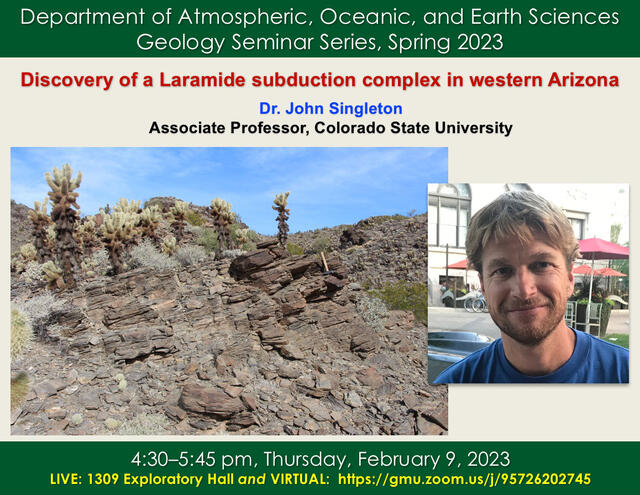
John Singleton, Colorado State University : Structural Geology
Live in 1309 Exploratory Hall
Virtual simulcast in Zoom: https://gmu.zoom.us/j/95726202745
Thursdays 4:30-5:45 pm
13 Feb (CLIM) Current Climate Conversation
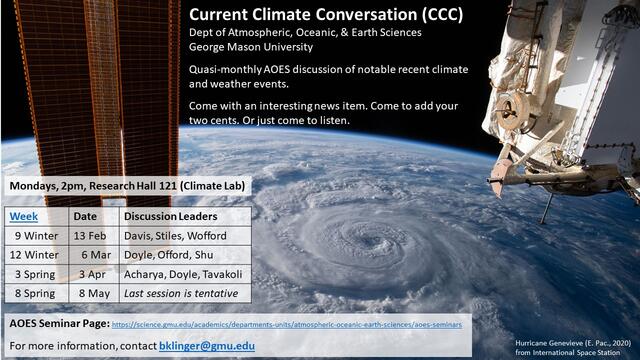
15 Feb (CLIM) Vuruputur: The Tale of Monsoon Rainfall
Venu Vuruputur, Indian Institute of Science
Wed 15 Feb, 1:30-2:30
JC Room G and via Zoom (contact bklinger@gmu.edu for link)
A Midlatitude Tale on the Tail of Indian Monsoon Rainfall
16 Feb (GEOL) Keisling, Geoscience Justice
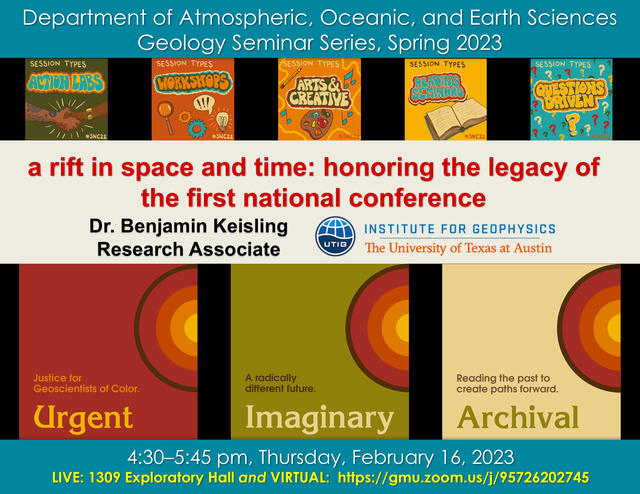
Ben Keisling, University of Texas at Austin: Geoscience Justice
Live in 1309 Exploratory Hall
Virtual simulcast in Zoom: https://gmu.zoom.us/j/95726202745
Thursdays 4:30-5:45 pm
22 Feb (CLIM) Zarzycki, Extreme Weather Risks
Colin Zarzycki, Pennsylvania State U
Wed, 22 Feb, 1:30-2:30
JC Room G and via Zoom (contact bklinger@gmu.edu for link)
Could it happen? Evaluating extreme weather risks with high-resolution climate storyline simulations
In this talk, we discuss using global Earth system model simulations of short, high-resolution, "storylines" to evaluate and communicate climate risk and potential changes in their associated hazards in the future. In particular, we focus on two flavors of storylines: gray swan tropical cyclones (physically plausible, but historically unrealized events extracted from multi-decadal climate ensembles) and rain-on-snow floods in a warmer world (resimulation of the 1996 Mid-Atlantic floods under different climate scenarios). We discuss scientific insights gained from these simulations, the strengths and limitations of this approach, and the potential benefits of using them to communicate with stakeholders and the general public.
23 Feb (GEOL) Grant, Planetary Geology
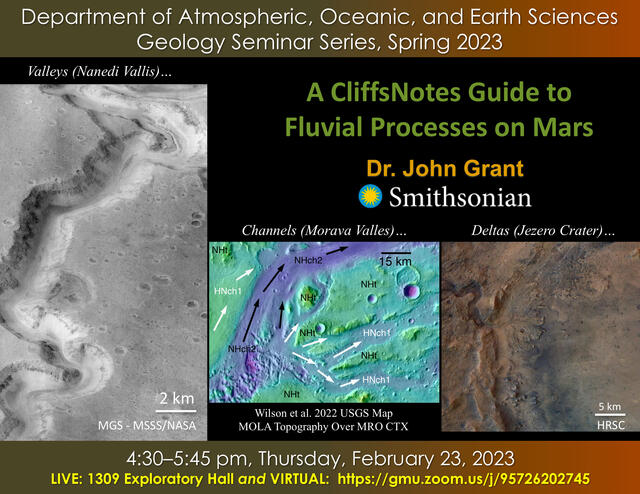
John Grant, Smithsonian: Planetary Geology
Live in 1309 Exploratory Hall
Virtual simulcast in Zoom: https://gmu.zoom.us/j/95726202745
Thursdays 4:30-5:45 pm
1 Mar (CLIM) Ramaswamy, Forced Changes in Hydrologic Cycle
*Please Note Room Change*
V “Ram” Ramaswamy, NOAA Geophysical Fluid Dynamics Laboratory
Wed, 1 Mar, 1:30-2:30
JC Room B and via Zoom (contact bklinger@gmu.edu for link)
Climate Forcings and Changes in the Hydrologic Cycle
A lot of attention has been given to the prospect of the surface temperature increase under the increased imbalance in the Earth’s radiation budget and climate change, and the downstream impacts e.g., continental-scale and marine heat waves. But what about the changes in the hydrologic cycle including evaporation and precipitation? What is our understanding about the changes concerning water over the 20th Century, and where does this take us to anticipate outcomes in the 21st Century? Can we improve upon the predictions and projections of extremes, including being able to do them across timescales? Can we provide substantive actionable information on climate adaptation, vulnerabilities, and mitigation, especially related to extremes concerning water, to the diverse array of stakeholders in the US and across the globe?
2 Mar (GEOL) Brooks, Precious Metals
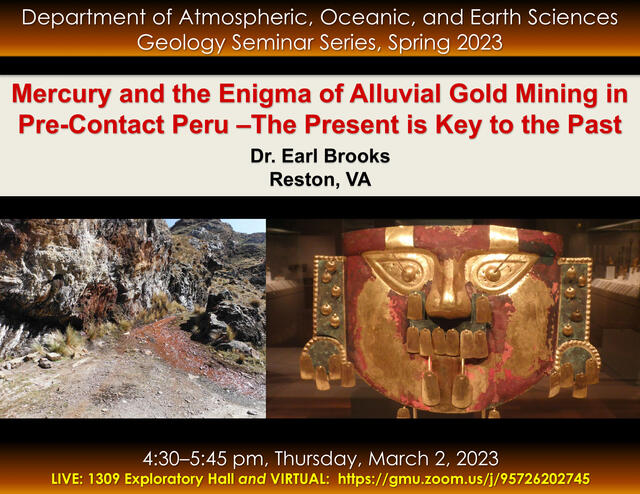
Brooks, Precious Metals
Live in 1309 Exploratory Hall
Virtual simulcast in Zoom: https://gmu.zoom.us/j/95726202745
Thursdays 4:30-5:45 pm
6 Mar (CLIM) Current Climate Conversation

8 Mar (CLIM) Dirmeyer, Land-Atmosphere Coupling from Satellites
Paul Dirmeyer, George Mason U
Wed, 8 Mar, 1:30-2:30
JC Room E and via Zoom (contact bklinger@gmu.edu for link)
Global Land-Atmosphere Coupling Metrics: Accounting for Measurement Noise in Satellite Data
9 Mar (CLIM) Powell, Cumulonimbus Clouds
Scott W. Powell, Naval Postgraduate School
Growth Mechanisms of Cumulonimbus Clouds
Thu, 9 Mar, 1:15pm
Exploratory Hall 3301 and via Zoom (contact zboybeyi@gmu.edu for link)
Moist convection in the atmosphere frequently takes the form of cumuliform clouds. Most of the time, such clouds arise from eddies in the boundary layer that reach the lifting condensation level and form shallow convection early in the cloud life cycle. The majority of cumulus (non-precipitating) clouds that develop remain shallow, but some of them are able to grow into taller—and often wider—cumulonimbus (precipitating) clouds. It is these deep and wide clouds that are linked to many types of severe weather events such as supercells and tropical cyclones. They also have profound impacts on the global atmospheric circulation through their extensive release of latent heat throughout the troposphere. In addition, they impact cloud-radiative feedbacks that result from the lateral development of cumulonimbi into broad stratiform regions containing extensive cirrus anvil clouds in the middle-to-upper troposphere.
Representing such clouds in numerical models of the atmosphere is particularly challenging. Cumulus clouds often form from updrafts no more than a few hundred meters wide, meaning that climate models and operational global weather models cannot resolve them. As a result, numerical models use cumulus parameterizations to capture the behavior of a population of many cumuliform clouds that can co-populate a single model grid cell. However, these parameterizations have significant limitations, among which are 1) vertical mass fluxes are often inconsistent with mass fluxes computed from observations and higher-resolution models; and 2) important processes, such as the onset of convection and entrainment of environmental air into convection, are usually sensitive to only the thermodynamic properties of the atmosphere and do not consider other important dynamic processes (such as pressure gradient accelerations) or cloud properties that might impact those processes (such as cloud size). The limitations in parameterizations mean that numerical models struggle to accurately depict both small-scale and large-scale weather and climate processes that depend on cumuliform clouds. This seminar will highlight a variety of Dr. Powell’s ongoing research that leverages both observations and high-resolution numerical modeling to investigate the timing and location of shallow to deep cumuliform cloud transitions.
9 Mar (GEOL) Cui, Stable Isotope Geochemistry
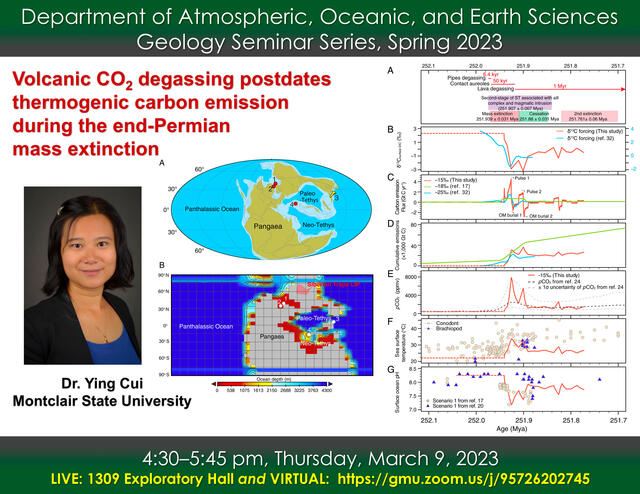
Ying Cui, Montclair State University: Stable Isotope Geochemistry
Live in 1309 Exploratory Hall
Virtual simulcast in Zoom: https://gmu.zoom.us/j/95726202745
Thursdays 4:30-5:45 pm
22 Mar (CLIM) Fernandes, ENSO & MJO in South America
Lais Fernandes, Portland State U
Wed, 22 Mar, 1:30-2:30
via Zoom (contact bklinger@gmu.edu for link)
The interaction between El Niño-Southern Oscillation (ENSO) and Madden-Julian Oscillation (MJO) in South America: observations and model simulations
The investigation shows how the ENSO phenomenon influences the impact of the Madden-Julian Oscillation (MJO) on South America during the summer monsoon season. Observations show that the MJO extratropical teleconnection and its impacts on South America intensify during El Niño (EN) and La Niña (LN) and weaken in neutral ENSO years. Simulations with ENSO also show that active ENSO states more efficiently trigger stronger MJO teleconnections than simulations without ENSO, indicating nonlinear ENSO effects on MJO-related anomalies. Convection over the source region, which triggers the extratropical teleconnection, is enhanced later in EN than in LN and is shifted slightly eastwards. Hence, the most significant impacts on South American precipitation happen later and more to the east in EN than LN.
23 Mar (GEOL) Kinsley, Geochronology
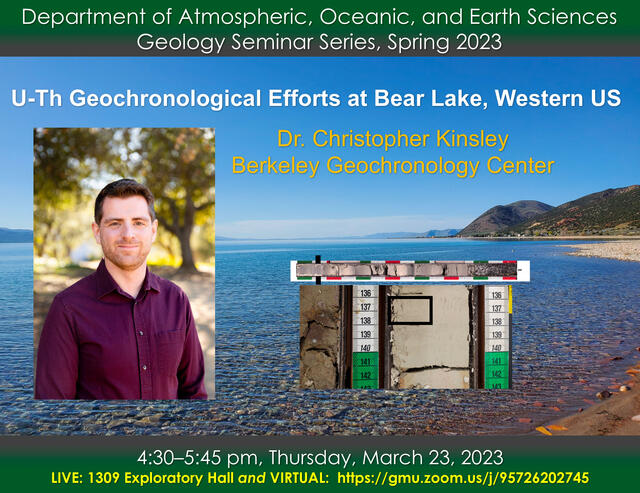
Chistopher Kinsley, Berkeley Geochronology Center: Geochronology
Live in 1309 Exploratory Hall
Virtual simulcast in Zoom: https://gmu.zoom.us/j/95726202745
Thursdays 4:30-5:45 pm
23 Mar (CLIM) Du, Hydroclimate History
Xiaojing Du, Rice University
The history of tropical hydroclimate: insights from proxy data and climate model
Thu, 23 Mar, 1:15-2:15 Room E and via Zoom (contact zboybeyi@gmu.edu for link)
Tropical ocean-atmosphere circulation exerts a powerful influence on the global climate system, driving global moisture and energy budgets and shaping regional hydroclimate patterns. However, the extent to which this system will be affected by future climate change remains uncertain and subject to ongoing debate. Paleoclimate studies offer a unique opportunity to understand the tropical hydroclimate response to external forcings and internal variability, which are crucial for predicting future climate conditions. Through data-model synthesis, we can integrate terrestrial and marine proxy records with high-resolution climate model simulations to reveal the spatiotemporal evolution of paleoclimate changes and their underlying physical mechanisms. In this talk, I will present my work that investigates how tropical hydroclimate has changed on interannual to orbital timescales since the last ice age, and how different regions have responded to various climate forcings by integrating proxy records with isotope-enabled transient climate model simulations. Additionally, I will discuss the teleconnections between tropical and mid-latitude regions that contribute to our understanding of global climate dynamics.
29 Mar (CLIM) Solmon, Aerosol-Monsoon Interactions
Fabien Solmon, Laboratoire D’Aérologie
Wed, 29 Mar, 1:30-2:30
JC Room C and via Zoom (contact bklinger@gmu.edu for link)
Aerosol - Monsoon interactions analyzed through regional climate modelling.
Understanding Monsoon Systems (MS) and their connection to global and regional climate has been a subject of intense research for decades. One important aspect of MS development is connected to the regional variability of diabatic and moisture sources affecting meridional energy gradients and rainfall distribution. This presentation will examine how natural and anthropogenic aerosol can interact with monsoon systems at the regional scale through feedback involving radiation, cloud and surface adjustments. A regional climate modelling approach will be introduced applied to studying how large quantities of aerosols from emitted dust and biomass burning can interact with West African monsoon dynamics and associated rainfall.
30 Mar (GEOL) Neumann, Planetary Physics
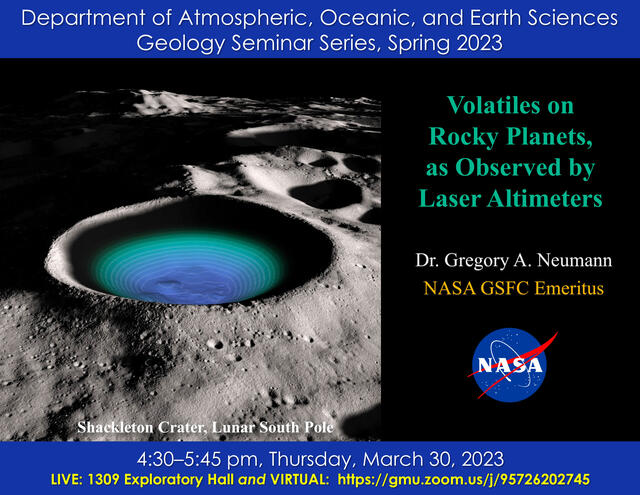
Greg Neumann, NASA: Planetary Physics
Live in 1309 Exploratory Hall
Virtual simulcast in Zoom: https://gmu.zoom.us/j/95726202745
Thursdays 4:30-5:45 pm
30 Mar (CLIM) Ahmed, Tropical rainfall
Fiaz Ahmed, U California Los Angeles
Reverse engineering convective physics from tropical rainfall statistics
Thu, 30 Mar, 1:15-2:15 Room TBA and via Zoom (contact zboybyi@gmu.edu for link)
Tropical convection affects us all. Interactions between tropical convection and its environment at the kilometer-scale can have consequences at the very largest scales. These interactions generate precipitation extremes, and modulate weather across the tropics and extratropics. However, relating convection to its environment at the small-scales is confounded by fast timescales (a few hours) and tight coupling with the dynamics. In this talk, I present a data-driven approach that leverages precipitation measurements to build a simple physical model of tropical convection. This model identifies (and helps construct) a cloud buoyancy measure from environmental thermodynamic variables. This buoyancy measure is shown to be the dominant thermodynamic control on precipitation across tropical land and ocean. Two applications of this precipitation-buoyancy relationship are presented. The first application introduces a new process-oriented diagnostic for Earth system models. The second application introduces a new theoretical framework for the Madden-Julian Oscillation (MJO). This talk will conclude with a discussion about ongoing efforts to transform the buoyancy framework into a data-driven, stochastic closure for intermediate-complexity models
3 Apr (CLIM) Current Climate Conversation

4 Apr (CLIM) Navarra, SST dynamics
Antonio Navarra, U Bologna and Euro-Mediterranean Center for Climate Change
Koopman decomposition of the SST dynamics Tue, 4 Apr, 2-3pm, EXPL 3301 and via Zoom (contact bklinger@gmu.edu for link)
In the last years, ensemble methods have been widely popular in atmospheric, climate, and ocean dynamics investigations and forecasts as convenient methods to obtain statistical information on these systems. In many cases, ensembles have been used as an approximation to the probability distribution that has acquired more and more a central role, as the importance of a single trajectory, or member, was recognized as less informative. Using results from the dynamical systems and more recent results from the machine learning and AI communities, we can arrive at a direct estimation of the probability distribution evolution and also at the formulation of predictor systems based on a nonlinear formulation.
The paper introduces the theory and discuss some examples for the analysis of the global SST
5 Apr (CLIM) Schneider, Decadal SST Variability
Edwin Schneider, AOES
Wed, 5 Apr, 1:30-2:30
JC Room E and via Zoom (contact bklinger@gmu.edu for link)
The Role of Atmospheric Noise in Decadal SST Variability
Decadal SST variability is investigated in a 500-year constant external forcing CGCM simulation. Comparison with a simulation made with an Interactive Ensemble (IE) version of the CGCM indicates that all decadal SST and AMOC variability is probably forced by surface fluxes produced by internal atmospheric noise. An approximate upper ocean heat budget is used to in conjunction with results from the IE to point to the resolution of a controversy concerning the relative roles of atmospheric noise net surface heat flux and ocean dynamics in internal decadal AMV variability. The result in the CGCM is that the atmospheric noise and ocean dynamics forcings of SST are about the same size, and that the ocean dynamics forcing has a longer time scale.
Schneider, E. K., B. Kirtman, and N. Perlin 2023: The role of atmospheric noise in decadal climate variability, J. Climate, 37, 2147-2166, DOI 10.1175/JCLI-D-22-0399.1.
6 Apr (GEOL) Song, Geological Engineering
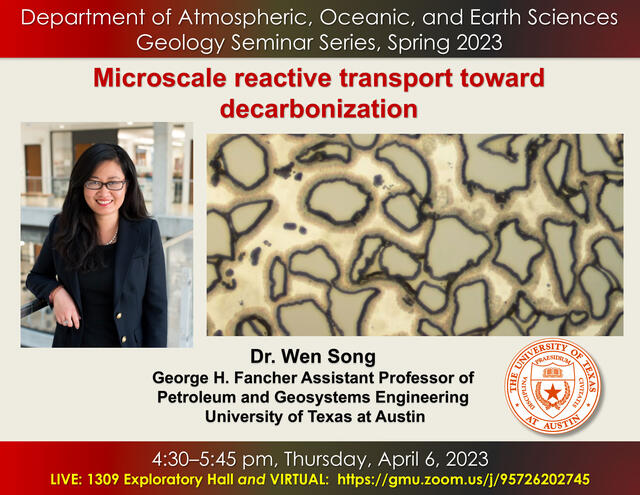
Wen Song, University of Texas at Austin: Geological Engineering
Live in 1309 Exploratory Hall
Virtual simulcast in Zoom: https://gmu.zoom.us/j/95726202745
Thursdays 4:30-5:45 pm
12 Apr (CLIM) Zhang, Hurricane Forecast System
Xuejin Zhang, NOAA Atlantic Oceanographic and Meteorological Lab (AOML)
Status of Hurricane Analysis and Forecast System (HAFS) Development: Initial Operational Capabilities and Future Priorities
Wed, 12 Apr, 1:30-2:30
via Zoom (contact bklinger@gmu.edu for link)
HAFS is planned to become the next-generation multi-scale numerical model for Tropical Cyclone (TC) application under the NOAA’s Unified Forecast System (UFS) in the 2023 hurricane season. It has five salient components: (1) storm-following telescopic moving nests, (2) high-resolution physics configured for TC application, (3) multi-scale Data Assimilation (DA) with vortex initialization, (4) atmosphere-ocean-wave coupling framework, and (5) intensive hurricane observational platforms to support the multi-scale DA system as well as the physics calibrations and system verifications/validations.
We will describe HAFS current status and the upcoming operational functionalities, i.e. Initial Operational Capabilities (IOC), development priorities in the next 2-3 years after implementing IOC in the 2023 hurricane season. The three-year retrospective forecast results of HAFS will be presented as
well in this presentation. We will also introduce some new research and forecast products for research and operations through HAFS. To accelerate the transition among development, operation, and community applications, we are developing a HAFS release plan under the guidance of HFIP and EPIC. We are looking for collaborative projects among academia, research labs, NOAA’s operational centers to improve HAFS in the future.
12 Apr (CLIM) Huang, Dissertation Defense-MJO Propagation
Kai Huang, Climate Dynamics Doctoral Defense
Understanding MJO Propagation in Observations and Models
Wed, 12 Apr, 9:00-10:00, Merton Hall rm 1202 and via zoom (contact dstraus@gmu.edu for link)
The Madden-Julian Oscillation (MJO), an eastward-propagating organized planetary-scale convection envelope, is the dominant subseasonal variability in the tropical atmosphere. The eastward propagation of MJO is influenced by various factors. This thesis investigates the roles of intraseasonal and interannual variations in limiting MJO propagation using both the observations and modeling work.
The observational work focuses on the MJO diversity in its propagation. The MJO events during the boreal winter seasons are categorized into four types including stand, jump, slow and fast MJO. Based on whether their convection penetrates the Maritime Continent (MC), stand and jump MJO are seen as non-penetrating (NP) MJO, while the rest two are seen as eastward-penetrating (EP) MJO. Results reveal the relative roles of the westward-propagating wave (WPW), as well as the QBO and ENSO, in limiting MJO propagation. Lack of the pre-moistening over the southern sea surface of the MC stops NP MJO from penetrating the MC. The active convection of the WPWs hinders the descending branch of the NP MJO circulation and therefore leads to the insufficient meridional advective moistening over the southern sea surface of the MC. The independent convection over the Pacific for jump MJO is influenced by a combined effect of the QBO and ENSO. The tropopause instability induced by MJO is found to significantly decouple from its convection over the Pacific in the QBOW winters than in the QBOE winters. For jump MJO, the independent convection over the central Pacific comes from local WPWs whose amplification and further development into deep convection are correlated to jump MJO's decoupled tropopause instability. For stand MJO, however, the seasonal-mean La Nina-like cool SST anomalies weaken the WPW activity over the central Pacific and confine WPWs within the western Pacific. Therefore, the decoupled tropopause instability of stand MJO is out phase of WPWs and fails to induce an independent convection over the central Pacific.
The modeling work focuses on the QBO's influences on MJO propagation as the QBO-MJO connection is very strong in the observation with a stronger MJO more likely to cross the MC in DJF seasons with QBO easterly (QBOE) phase than with QBO westerly (QBOW) phase. However, such connection is missing in all current-generation climate models. To address this question, two strong MJO cases in a QBO neutral (QBON) boreal winter are investigated. The QBO temperature and zonal wind anomalies are added separately as well as together to the stratosphere using nudging in MJO case hindcast with the CESM2 subseasonal prediction system. Only by nudging the QBO temperature anomalies while leaving the zonal wind free, the prediction system can capture the observed QBO-MJO connection. The tropopause instability is found positively correlated to the MJO amplitude, but it cannot fully explain the captured connection. The free-evolving zonal wind anomalies in the stratosphere due to the nudged QBO temperature are crucial for the captured connection. The same nudging strategies are applied to CESM2 to generate the 35-year simulations with 3 ensemble members with a reasonable stratospheric QBO. Results show that a weak QBO-MJO connection over the MC is captured when the zonal-mean zonal and meridional wind components are nudged in the model stratosphere. However, the captured QBO-MJO connection is shifted southward following the southward shift in the DJF mean MJO activity over the MC by CESM2. Also, the captured QBO-MJO connection is not reflected by OLR MJO index (OMI) as it is insufficient to represent the DJF MJO activity over the most part of MC in CESM2. The discrepancy between the appropriate nudged variables to capture QBO-MJO connection in initialized MJO hindcast and uninitialized simulations indicate that the there might be more than one physical mechanism by which the QBO could influence MJO.
13 Apr (GEOL) Linzmeier, Invertebrate Paleontology
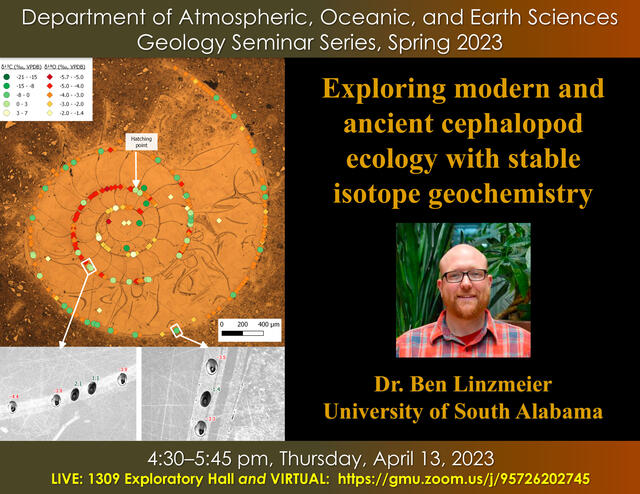
Ben Linzmeier, University of Southern Alabama: Invertebrate Paleontology
Live in 1309 Exploratory Hall
Virtual simulcast in Zoom: https://gmu.zoom.us/j/95726202745
Thursdays 4:30-5:45 pm
17 Apr (CLIM) Joshi, Dissertation Defense
Janak Joshi, Climate Dynamics Doctoral Defense
Modeling and Predictability of Dust Storms and Atmospheric Dustiness over the Western United States
Mon, 17 Apr, 10:00-11:00, Exploratory Hall 3301
Windblown dust and dust storms impact the Earth’s radiative energy balance and adversely affect public health. This dissertation addresses five major topics on windblown dust: model improvement (including source attribution of dust); predictability of the physics-based dust storm model; and physics-informed statistical modeling and predictions for, and climatology and variability of the observed, seasonal mean dustiness over the western United States.
Click Here for Full Dissertation Abstract
19 Apr (CLIM) Chen, Mesoscale Effects on Deep Convection
Jack Chen, NCAR
Effects of organized mesoscale convection on the characteristics of deep convection simulated by E3SMv2
Wed, 19 Apr, 1:30-2:30
Zoom (contact bklinger@gmu.edu for link)
Organized mesoscale convection, frequently embedded within deep convection, cannot be resolved in general circulation models. A parameterization aiming at representing the atmospheric circulation of organized mesoscale convection is implemented in Energy Exascale Earth System Model Version 2 (E3SMv2). The parameterization is found to improve model representation of tropical variability. However, it degrades the mean state precipitation in certain regions. In this study, we examine how the mesoscale convection parameterization interferes with deep convection and the mechanism which may lead to degradation of mean state precipitation in model simulations. A refined version of the parameterization is then implemented which is shown to simultaneously remedy the degradation of the mean state climatology and further improve tropical variability.
20 Apr (GEOL) Ge, Hydrogeology

Shemin Ge, University of Colorado: Hydrogeology
Live in 1309 Exploratory Hall
Virtual simulcast in Zoom: https://gmu.zoom.us/j/95726202745
Thursdays 4:30-5:45 pm
24 Apr (CLIM) Smith: RMSE is Evil
Lenny Smith, Virginia Tech
On the Evaluation and Tuning of Probability Forecasts: Why RMSE is Evil and Anomalies are Silly
Mon, 24 Apr, 1pm
Johnson Center Mtg Rm A and Zoom (contact bklinger@gmu.edu for link)
26 Apr (CLIM) Douglas Nedza, North Atlantic SST
Douglas Nedza, AOES Climate Dynamics Program
Wed, 26 Apr, 1:30-2:30
JC Room A and via Zoom (contact bklinger@gmu.edu for link)
Understanding Contributions to Variance in North Atlantic Sea Surface Temperatures
Quantifying the relative contributions of external forcing and internal variability to North Atlantic Sea Surface Temperatures (NASST) has important implications for attributing and predicting climate changes around the North Atlantic basin. Virtually all previous methods have approached this problem by estimating the externally forced signal directly, either from climate models or using statistical filtering methods. These methods make strong assumptions about the forced variability which are not universally accepted. In this work, we approach this problem in a fundamentally different way that avoids controversial assumptions about the externally forced variability. Specifically, we estimate internal variability directly and then compute the forced variability as the residual. This approach is a form of dynamical adjustment, although this implementation differs from previous applications.
27 Apr (GEOL) Students
Live in 1309 Exploratory Hall
Virtual simulcast in Zoom: https://gmu.zoom.us/j/95726202745
Thursdays 4:30-5:45 pm
3 May (CLIM) Pallozzi, Tornado Warnings
Kyle Pallozzi, National Weather Service
Wed, 3 May, 1:30-2:30
JC Room C and via Zoom (contact bklinger@gmu.edu for link)
Evaluating & warning for severe thunderstorms/tornadoes
4 May (GEOL) Students
Live in 1309 Exploratory Hall
Virtual simulcast in Zoom: https://gmu.zoom.us/j/95726202745
Thursdays 4:30-5:45 pm
10 May (CLIM) Undergraduate Research Talks
CLIM 408 Students
Wed, 10 May, 1:00-2:30, Research Hall 121
(inside Climate Dynamics Suite)
1 Jun (CLIM) Kirtman, Ocean Processes in Climate Variability
Ben Kirtman, U Miami
Understanding the Role of Meso-Scale Ocean Processes in Seasonal-to-Decadal Climate Variability and Predictability
Thu, 1 Jun, 11am Exploratory Hall 3301 and via Zoom (contact bklinger@gmu.edu for link)
7 Jun (CLIM) Gaal, Dissertation Defense – Summer Convective Systems
Rachel Gaal, Climate Dynamics Dissertation Defense
Wed 7 Jun, 11:00-12:30, Research Hall 121 (inside Climate Suite) and via Zoom (email ikinter@gmu.edu)
The Role of Soil Moisture State on the Incidence of Summer Mesoscale Convective Systems in the U.S. Great Plains
Mesoscale convective systems (MCS) are known to develop in strongly-forced synoptic environments, but recent work has shown that summer MCS events in the U.S. Great Plains can occur in weakly-forced synoptic environments, and convection in this case may be triggered by anomalous soil moisture (SM) conditions. Using an MCS database covering the contiguous U.S. east of the Rocky Mountains in boreal summers 2004–17, this dissertation aims to identify the SM conditions associated with summertime MCS initiations in the U.S. Great Plains, and to identify a mechanism of interaction between the SM state and MCS initiation through the lens of local land-atmosphere (L-A) coupling. MCS events that occur in weakly-forced synoptic environments are isolated using the Convective Triggering Potential and Low Level Humidity Index (CTP-HI_low), and their SM conditions are evaluated centered on the mean initiation position of a 5° X 5° domain. At larger scales [O(100) km], soil moisture heterogeneity, where anomalously dry soils (anomalously wet soils) are located southwest (northeast) of the initiation point, is associated with MCS initiation. These dry and wet soils set up a surface temperature gradient, which is hypothesized to produce a surface pressure gradient that drives a near-surface wind perturbation with convergence and upward motion to stimulate convection. To test this hypothetical mechanism, numerical experiments are performed with the Weather Research and Forecasting (WRF) model by imposing idealized, exaggerated SM perturbations (PB) having varying organizations and alignments to the near-surface wind. The MCS initiation locations are used as the center point for a 5° X 5° domain where SM is changed, with five total SM PB.
A storm-centered analysis of SM showed that PB-1, where SM is uniformly set to a near-wilting point in the experiment domain, was the only experiment that consisted of organized heterogeneity [O(100)km], structured as significantly drier soils in the southwest transitioning to wetter soils in the northeast. Further analyses showed the PB-1 experiment demonstrated the largest thermodynamic and dynamic response, where the mechanism of interaction was driven by SM values in the transitional regime promoting strong local L-A coupling (these SM values are associated with smaller evaporative fraction and larger sensible heat flux values that influenced the growth of the PBLH), and the spatial SM gradient aligned with the near-surface wind produced additional uplift to generate convection. While the PB-1 experiment was intended to evaluate the response to homogeneously dry SM, an artifact of imposition of the SM perturbation in the model domain set up a large dry-to-wet SM gradient along the eastern and northern edges of the PB area, and MCS initiations were subsequently preferred over those transition zones. These cumulative findings are similar to the previous results in the Sahel that suggest SM heterogeneity can drive MCS initiation, with meso-β circulations related to near-surface variable fluctuations as the main mechanism of interaction.
12 Jul (CLIM) Nelson, The Taxonomy and Phylogeny of the Squalodontidae (Cetacea, Odontoceti), and Implications for the Fossils Record of Whales
Margot Nelson, M.S., Dissertation Defense
Wed 12 July, 10:00am-11:00am, Exploratory 1309
The Squalodontidae is a family of archaic odontocetes, or toothed whales, with a nebulous taxonomy and phylogenetic position. The family has long been considered a “wastebasket” containing many fragmentary cetacean fossils, and most species within the family are poorly understood by paleontologists. This Dissertation achieves the comprehensive review of the Squalodontidae by (1) removing species named from fragmentary material, (2) revitalizing the taxonomy of the most significant species within the family, Eosqualodon langewieschei and Squalodon grateloupii, and (3) placing the Squalodontidae into an analysis of evolutionary relationships. The results of these studies have elevated the Squalodontidae from wastebasket status, and clarified the evolution of key traits within the Odontoceti.
Fall 2022 AOES Seminars
31 Aug (CLIM) Swenson, Monsoon Teleconnections
Erik Swenson, George Mason U
Wed, 31 Aug, 1:30-2:30
EXPL 3301 and via Zoom (contact bklinger@gmu.edu for link)
Indian monsoon teleconnections with ENSO in an ensemble of re-forecasts
The El Niño Southern Oscillation (ENSO) has a significant impact on the Indian summer monsoon, with more dry conditions (relative to normal) expected during El Niño and more wet conditions during La Niña. In this study we examine the ENSO-monsoon relationship in an ensemble of re-forecasts produced with the NCEP CFSv2 and compare with the observed relationship. A large sample size allows for higher-order details of the ENSO-monsoon relationship to be quantified with significance. We examine the seasonal mean relationship in such a way that allows for potential nonlinearity and introduce a novel modification of Principal Component Analysis to incorporate asymmetry. Extending the analysis to sub-seasonal timescales, we further diagnose the impact of ENSO on the monsoon active-break cycle. Preliminary results suggest that ENSO does not systematically alter the active-break phases, and the impact over central India is independent.
1 Sep (GEOL) Tarduno, Early Earth Paleomagnetism
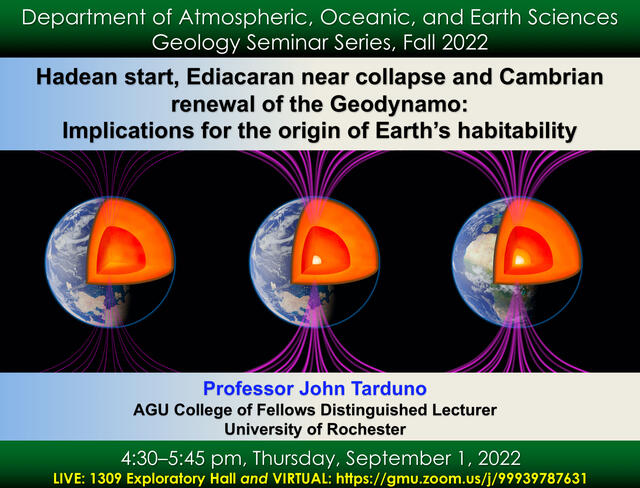
John Tarduno, University of Rochester – Early Earth paleomagnetism
Thursdays, 4:30-5:45 pm
Virtual in Zoom: https://gmu.zoom.us/j/99939787631
7 Sep (CLIM) Coelho, Flood Resilience, Climate, and Forecasting
Gustavo de Almeida Coelho, Furman U Wed, 7 Sep, 1:30-2:30, via Zoom (contact bklinger@gmu.edu for link)
Towards Flood Resilience in Metropolitan Areas: Planning for Climate Uncertainty and Real-time Flood Forecasting
Urban floods generated by heavy and short-duration rainfall are a major concern due to their potential socioeconomic impacts and threat to life. I will discuss two approaches to support flood resilience in metropolitan areas. (1) In longer-term planning horizon (years to decades) I assess changes in future extreme precipitation due to climate change and present a novel method to incorporate these changes in flood engineering design. This method can support water resources engineers and decision-makers in planning for climate uncertainty. (2) In short-term (hours to days) I explore the predictive capability of flood forecast systems integrating numerical weather prediction to urban scale hydrodynamic models. This research advances urban flood modeling by highlighting key insights on short-range real-time flood predictability that can guide preparedness and response to approaching flood events.
8 Sep (GEOL) Segessenman, Precambrian Chronostratigraphy
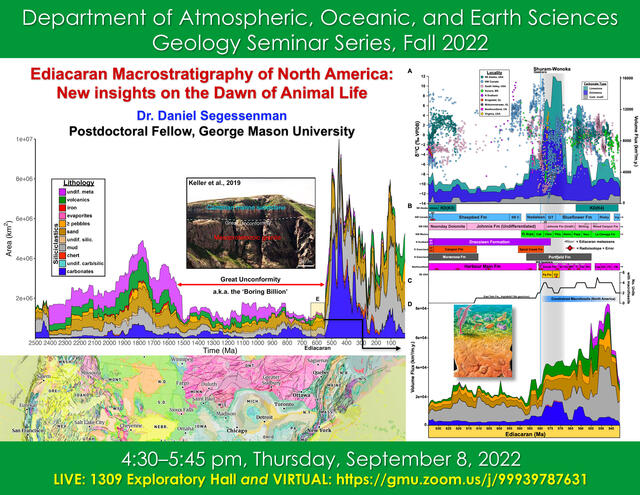
Dan Segessenman, George Mason University – Precambrian chronostratigraphy
Thursdays, 4:30-5:45 pm
1309 Exploratory Hall
Virtual simulcast in Zoom: https://gmu.zoom.us/j/99939787631
14 Sep (CLIM) no seminar
15 Sep (GEOL) Wyss, Earthquake risks in the Himalayas

Max Wyss, International Centre for Earth Simulation – Earthquake risks in the Himalayas
Thursdays, 4:30-5:45 pm
Virtual simulcast in Zoom: https://gmu.zoom.us/j/99939787631
16 Sep (CLIM) Current Climate Conversation
Austin Reed, Nikki Lydeen, and others
Fri, 16 Sep, 11:00-12:00,
Research Hall 121 (CLIM Lab) & via zoom (contact bklinger@gmu.edu for link)
Quasi-monthly AOES discussion of notable recent climate and weather events. Come with an interesting news item. Come to add your two cents. Or just come to listen
22 Sep (GEOL) Nohl, Aragonite and Diagenesis
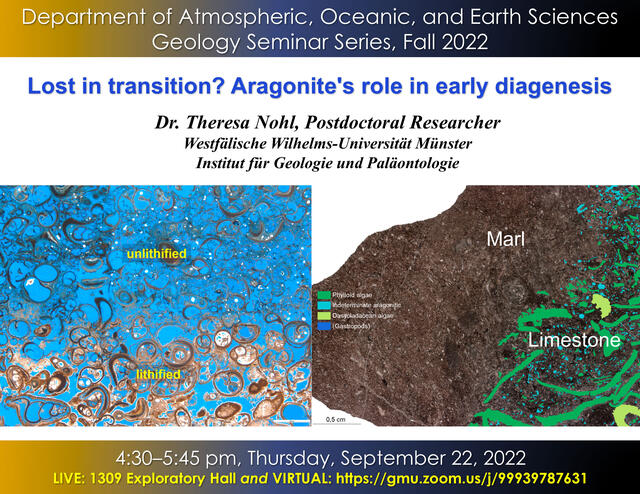
Nohl, Aragonite and Diagenesis
Thursdays, 4:30-5:45 pm
28 Sep (CLIM) Zhu, Clouds and Paleoclimate
Jiang Zhu, National Center for Atmospheric Research (NCAR)
Wed, 28 Sep, 1:30-2:30,
Johnson Center Mtg Rm G and via Zoom (contact bklinger@gmu.edu for link)
Clearing clouds of uncertainty with the help of paleoclimate
The cloud feedback has long been identified as the leading source of uncertainty in the climate forcing-feedback framework, dominating the inter-model spread in how the global-average temperature responds to CO2 doubling, the equilibrium climate sensitivity (ECS). The increase of cloud feedback in the most recent generation of models is also responsible for the higher ECS than the previous generation of models. It is of paramount importance that we reduce the uncertainties associated with the cloud feedback processes. In this talk, I use the Community Earth System Models as an example to show how we can constrain the cloud parameterizations and feedback through simulation of past climate changes. Specifically, the paleoclimate simulations suggest that models with too strong or too weak cloud feedback may fail to simulate realistic ice age and/or hothouse climates in Earth’s past. I also discuss the potential role of the state dependence of the cloud feedback in the application of paleoclimate constraint
29 Sep (GEOL) Goring, Paleoclimate-Paleobiota Interactions
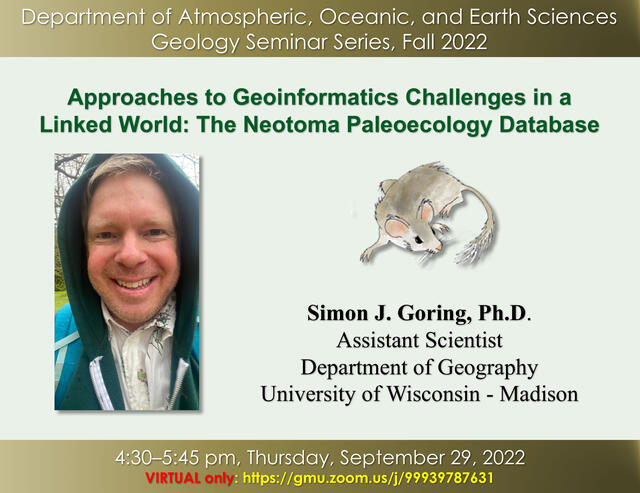
Simon Goring, University of Wisconsin – Paleoclimate-Paleobiota Interactions
Thursdays, 4:30-5:45 pm
Virtual simulcast in Zoom: https://gmu.zoom.us/j/99939787631
5 Oct (CLIM) Chaney, Heterogeneity in Land-Air Interaction
Nathaniel Chaney, Duke U
Modeling the role of surface heterogeneity in land-atmosphere interactions
Wed, 5 Oct, 1:30-2:30 Johnson Center Mtng rm G and via Zoom (contact fhaychap@gmu.edu) for link
6 Oct (GEOL) Ackerman, Early Earth Geology
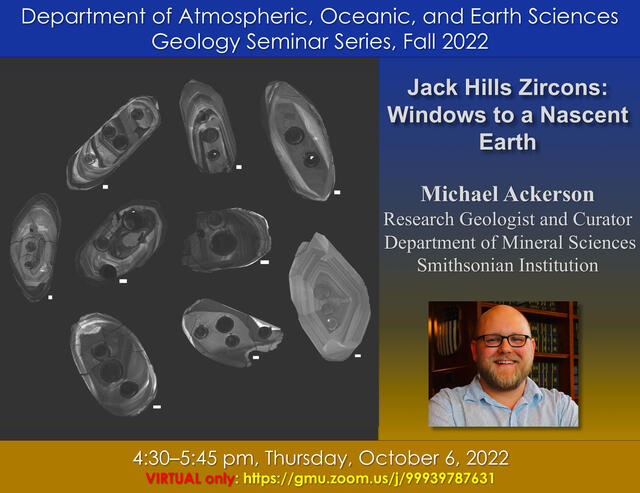
Mike Ackerman, Carnegie Institute for Science – Early Earth Geology
Thursdays, 4:30-5:45 pm
Virtual simulcast in Zoom: https://gmu.zoom.us/j/99939787631
12 Oct (CLIM), Straus, Global Consequences MJO
David Straus, George Mason U
Wed, 12 Oct, 1:30-2:30, Johnson Center Mtng Rm G and via Zoom (contact bklinger@gmu.edu for link)
Global consequences of uncertainty in heating within the Madden-Julian Oscillation
13 Oct (GEOL) Sidor, Vertebrate Paleontology
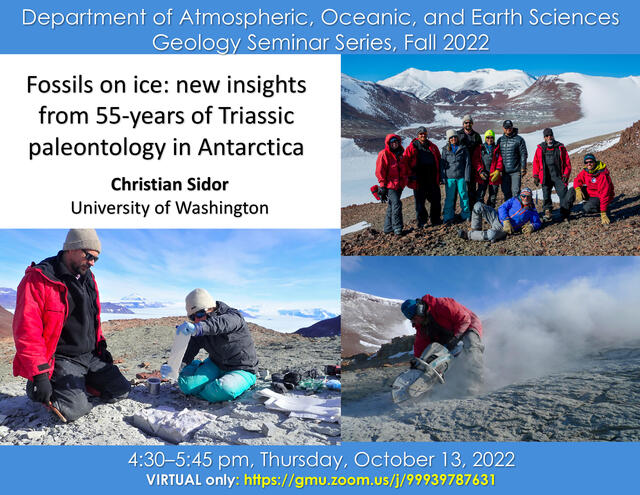
Christian Sidor, University of Washington – Vertebrate Paleontology
Thursdays, 4:30-5:45 pm
Virtual simulcast in Zoom: https://gmu.zoom.us/j/99939787631
14 Oct (CLIM) Current Climate Conversation
Reilly Stiles and others
Fri, 14 Oct, 11:00-12:00,
Research Hall 121 (CLIM Lab) & via zoom (contact bklinger@gmu.edu for link)
Quasi-monthly AOES discussion of notable recent climate and weather events. Come with an interesting news item. Come to add your two cents. Or just come to listen.
19 Oct (CLIM) Fedorov,El Nino and Global Warming
Alexey Fedorov, Yale U
The response of the tropical Pacific mean state and ENSO to global warming
Wed, 19 Oct, 1:30-2:30, Johnson Center Mtng Rm C and via Zoom (contact bklinger@gmu.edu for link)
20 Oct (GEOL) Shevenell, Evolution of Antarctica
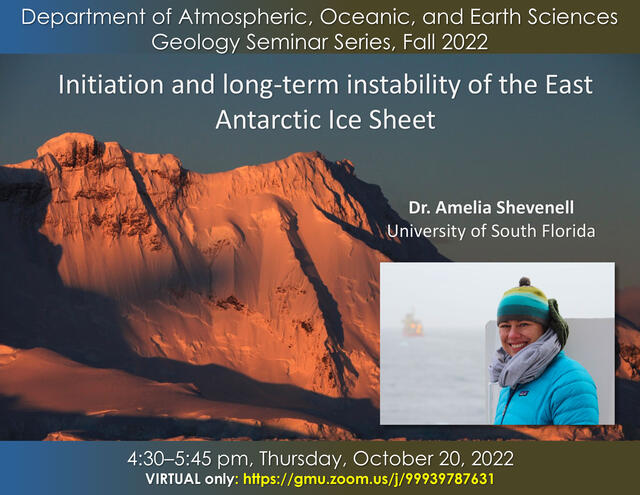
Amelia Shevenell, University of South Florida – Evolution of Antarctica
Thursdays, 4:30-5:45 pm
Virtual simulcast in Zoom: https://gmu.zoom.us/j/99939787631
26 Oct (CLIM) Joh, Kuroshio Variability Under Climate Change
Youngji Joh, Princeton U
Stronger decadal variability of the Kuroshio Extension under simulated future climate change
Wed, 26 Oct, 1:30-2:30, via Zoom (contact bklinger@gmu.edu for link)
Understanding the behavior of western boundary current systems is crucial for predictions of biogeochemical cycles, fisheries, and basin-scale climate modes over the midlatitude oceans. In this talk, I will address the response of the North Pacific’s Kuroshio Extension (KE) variability to future climate change scenarios. Large-ensemble climate model simulations show that in response to increasing greenhouse gases, the time scale of KE sea surface height (SSH) shifts from interannual scales toward decadal and longer scales. Greenhouse warming leads to a positive KE state that restricts ocean perturbations, enhancing decadal KE modulations relative to short-time scale variations. Our spectral analyses suggest that anthropogenic forcing may alter the future predictability of the KE system.
27 Oct (GEOL) Weitz, Mars Geology
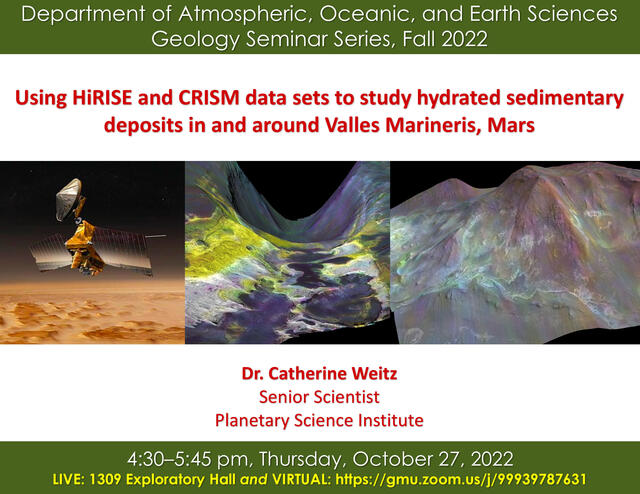
Cathy Weitz, Planetary Science Institute – Mars Geology
Thursdays, 4:30-5:45 pm
1309 Exploratory Hall
Virtual simulcast in Zoom: https://gmu.zoom.us/j/99939787631
28 Oct (GEOL) McBride, Holocene Barrier Systems in Australia
Randolph A. McBride, George Mason U
The Turnaround from Transgression to Regression of Holocene Barrier Systems in Southeastern Australia: Geomorphology, Geologic framework, and Geochronology
Fri, 28 Oct, 1:30-2:30, via Zoom (contact pdirmeye@gmu.edu for link)
Holocene regressive strandplains that preserve a series of former shorelines are extensive on coasts that were remote from major Pleistocene ice sheets (for example, Australia and Brazil), whereas transgressive barrier islands are typical in glacial forebulge regions (for example, North America and Europe). In strandplains, the regressive phase of strandline development was preceded by a transgressive phase during the final stages of postglacial sea-level rise. This study examines the turnaround from transgression to regression through chronostratigraphic description of three barrier systems in south-eastern Australia: Seven Mile Beach, Bengello Beach and Pedro Beach. The geomorphic and depositional histories are reconstructed using ground-penetrating radar (GPR) and vibracores along transects across the landwardmost ridges, and optically-stimulated luminescence (OSL) and radiocarbon dating (C-14). At the Seven Mile Beach barrier system, extensive washover deposits are preserved that include distinctive, landward-directed, flame-shaped washover fans along the bayside shoreline of the landwardmost ridge. Landward-dipping ground-penetrating radar reflections in radargrams provide evidence of the culmination of the transgressive phase and transition into the regressive phase dominated by progradation, evidenced by the change to seaward-dipping reflections. A similar progradational plain formed at the Bengello Beach barrier system, but transgressive deposits are largely absent at the site investigated, where an eroded headland created limited accommodation space until sand supply was sufficient for progradation. The Pedro Beach barrier system depositional history is more complex. There, a smaller embayment filled rapidly during the mid-Holocene, and transgressive sands were deposited as sea level reached its present level and impounded a wetland. Accommodation space in the embayment was filled by ca 4000 years ago. Overall, results indicate that the Holocene turnaround transition occurred between 8400 and 7000 years ago, and was preserved at the landward margin of these three strandplains. Holocene morphostratigraphy differs among sites primarily as a function of sea level, sediment supply, and antecedent topography.
28 Oct (CLIM) Tong, Extreme Air Quality Events in Changing Climate
Daniel Tong, George Mason U
Extreme Air Quality Events and Societal Effects in a Changing Climate
Fri, 28 Oct, 2:45-3:45 via zoom (contact bklinger@gmu.edu for link)
2 Nov (CLIM), DelSole, How to choose a scientific problem
Tim DelSole, George Mason U
Wed, 2 Nov, 1:30-2:30, Johnson Center Mtng Rm G and via Zoom (contact bklinger@gmu.edu for link)
Things I wish I learned in Graduate School: How to choose a scientific problem
3 Nov (GEOL) Kinsley, Geochronology
Christopher Kinsley, Berkeley Geochronology Center – Geochronology
Thursdays, 4:30-5:45 pm
Virtual simulcast in Zoom: https://gmu.zoom.us/j/99939787631
9 Nov (CLIM) Molina, Machine Learning to Extend Prediction
Maria Molina, U Maryland College Park
Using Machine Learning to Extend Earth System Prediction
Wed, 9 Nov, 1:30-2:30
Johnson Center Mtng Rm G and via Zoom (contact bklinger@gmu.edu for link)
Chaos theory, which is the concept of sensitivity to initial state for numerical weather prediction, is at the root of why the skillful deterministic prediction of weather at the subseasonal-to-seasonal (S2S) timescales using state-of-the-art forecasting models remains extremely challenging. Predictability stemming from atmospheric initial conditions is also substantially reduced beyond approximately two weeks and the ocean generally does not offer added predictability until a trajectory reaches the seasonal timescale. These challenges motivate the use of machine learning methods for S2S prediction. Two approaches for S2S prediction will be highlighted: (1) an unsupervised learning approach and (2) a supervised learning approach. The first study focuses on assessing the representation and predictability of North American weather regimes, which are persistent large-scale atmospheric patterns. The second study focuses on the use of a deep learning model (specifically a U-Net) for bias correction of S2S forecasts of global temperature and precipitation.
10 Nov (GEOL) Algeo, Geochemistry
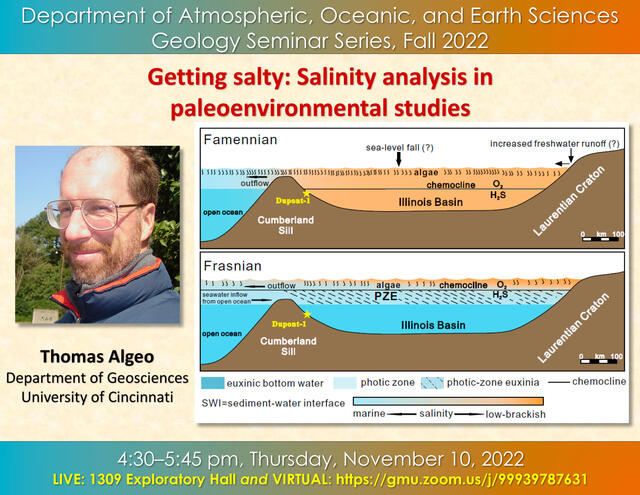
Tom Algeo, University of Cincinnati – Geochemistry
Thursdays, 4:30-5:45 pm
Zoom: https://gmu.zoom.us/j/99939787631
11 Nov (CLIM) Current Climate Conversation
Alia Wofford, Briah’ Davis, and others
Fri, 11 Nov, 11:00-12:00, via Zoom (contact bklinger@gmu.edu for link)
Quasi-monthly AOES discussion of notable recent climate and weather events. Come with an interesting news item. Come to add your two cents. Or just come to listen.
15 Nov (CLIM) Hsu, Dissertation Defense, Surface Heat Flux
Hsin Hsu, George Mason U
Climate Dynamics Dissertation Defense
Nonlinearity and Regimes in Global Soil Moisture-Surface Heat Flux Coupling
Tue, 15 Nov, 12:00-1:00
Johnson Center Meeting Room E (334) and via zoom (Contact bklinger@gmu.edu for link)
Advisor: Paul Dirmeyer
Feedbacks on the atmosphere induced by soil moisture variability are recognized as an essential component of the Earth system. Coupling between SM and surface heat fluxes, especially the latent heat flux (LE), is the foundation of these feedbacks as it exchanges water and energy between the interface of land and atmosphere. Building upon that, this dissertation aims to understand land-atmosphere interactions by exploring the nonlinearity, multivariable dependency, and regime characteristics in the SM:LE coupling at a global scale. I show that LE is significantly affected by both SM and net radiation not only linearly but also nonlinearly and synergistically. Then, I determine active and inactive regimes in SM:LE sensitivity and confirm spatial patterns of SM:LE dependency during active regimes are consistent among observations and climate models. Nevertheless, the spatial patterns of the existence of local coupling regimes reflecting hydroclimate are diverse. I further find that, under global warming, the locally dominant regime may change, and projected SM variability tends to span more regimes. These changes in the dominant regime are decomposed into contributions from moisture processes and energy processes using a novel framework. Results show moisture processes result in a more moisture-limited world while the energy effect is also significant, but its impact is inconsistent among climate models. The global patterns computed in this research not only shed new light on aspects of land-atmosphere interactions but also raise several follow-up topics worthy of further study.
16 Nov (CLIM) Naik, Short-Lived Climate Forcing in AR6
Vaishali Naik, Princeton U
The role of short-lived climate forcers (SLCFs) in the climate system – key findings from the IPCC AR6
Wed, 9 Nov, 1:30-2:30 Johnson Center Meeting Rm G and via Zoom (contact bklinger@gmu.edu for link)
17 Nov (GEOL) Brennan, CO2 Sequestration
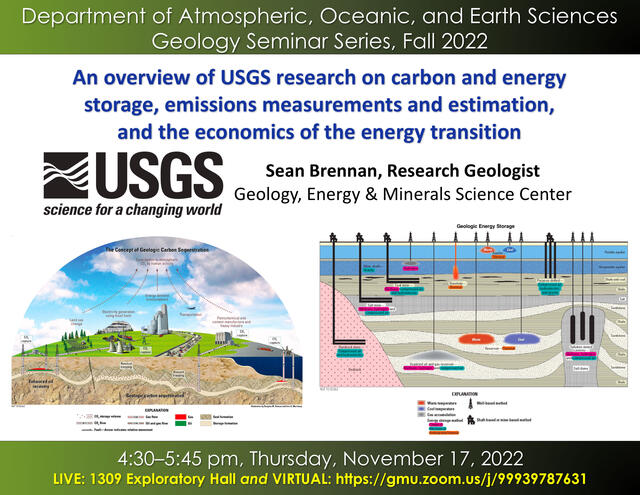
Sean Brennan, US Geological Survey – CO2 sequestration
Thursdays, 4:30-5:45 pm
1309 Exploratory Hall
Virtual simulcast in Zoom: https://gmu.zoom.us/j/99939787631
30 Nov (CLIM) Klinger, Eastern Boundary Upwelling
Barry Klinger, George Mason U
Wed, 30 Nov, 1:30-2:30,
Eastern Boundary Upwelling – Where does the Heat Go?
Johnson Center Meeting Rm G and via Zoom (contact bklinger@gmu.edu for link)
Oceans have distinctive coastal upwelling zones that can be 4oC cooler than surroundings. Climate models still struggle to accurately reproduce the zones, which affect the larger climate system by pulling heat out of the atmosphere. Ultimately the magnitude of this ocean heat gain must be set by a balance with ocean heat loss somewhere else. Here we examine ocean-only numerical experiments to address the question: Once the heat enters the ocean in the Peruvian Upwelling Zone, where does it go? To isolate the upwelling effects, we compare simulations with and without upwelling-favorable winds. Along the way we tour a near-global gyre associated with the coastal wind, an Ekman-layer overturning circulation, and perturbations to northern hemisphere tropical circulation by southern hemisphere wind.
1 Dec (GEOL) Haynes, Paleoceanography
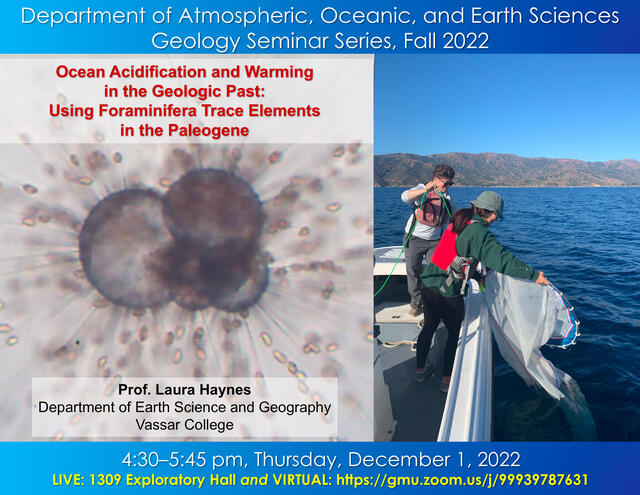
Laura Haynes, Vassar College – Paleoceanography
Thursdays, 4:30-5:45 pm
Virtual simulcast in Zoom: https://gmu.zoom.us/j/99939787631
2 Dec (CLIM) Current Climate Conversation - cancelled
This week's edition of CCC has been cancelled.
Fri, 16 Sep, 11:00-12:00, Research Hall 121 (CLIM Lab)
Quasi-monthly AOES discussion of notable recent climate and weather events. Come with an interesting news item. Come to add your two cents. Or just come to listen.
